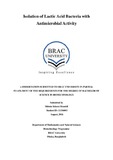Isolation of lactic acid bacteria with antimicrobial activity

View/
Date
2016-08Publisher
BRAC UniversityAuthor
Shembil, Sihinta SabeenMetadata
Show full item recordAbstract
The benefits of live cultures as probiotics have been known for a long time throughout the world; probiotics can improve immunity, prevent diseases and much more. Probiotics can be a great substitute for antibiotics. Fortunately, Lactic Acid Bacteria (LAB) are ubiquitous in nature. In the present investigation, 35 different food samples were analyzed and of them six contained LAB. Three types of Lactic Acid Bacteria were derived from bitter gourd, brinjal, broccoli, cauliflower, maize and potato: Streptococcus, Enterococcus and Lactobacillus. The aim, with these bacteria, was to observe their antimicrobial activity as whole cells and to check if they produce bacteriocin, a high molecular weight peptide; for both these tests, it was observed if growth of six selected pathogenic strains would occur or would be inhibited in the presence of whole cells and supernatants. Gram positive and Gram negative pathogenic strains were selected: B. subtilis, B. cereus, E.coli, S. aureus, S. flexneri and S. pneumoniae. To test the antimicrobial activity of the whole cells against the selected strains, the agar overlay method was applied. Well diffusion method was used to investigate the presence of bacteriocins with antimicrobial properties; this method was done with both crude supernatant and supernatant precipitated with ammonium sulphate. The agar overlay method requires the isolate to be stabbed into MRS (de Man, Rogosa and Sharpe) agar and incubated anaerobically for 24 hours at 37° C, and then soft agar seeded with pathogen was poured evenly on top. This was incubated for another 24 hours at 37° C. After conducting the agar overlay method zones of inhibitions were present. It was seen that all of the isolates inhibited all of the pathogenic strains, except for the isolate from brinjal against S. pneumoniae. As for the well diffusion method, Mueller-Hinton agar requires the pathogen to be swiped on its surface and the agar to be punctured to make wells, and then the supernatant of the LAB isolates were dispensed into the wells; this was incubated for 18-24 hours at 37° C. No antimicrobial activity was observed through the well diffusion method.
